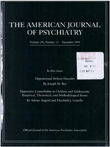Comparison of acetorphan with clonidine for opiate withdrawal symptoms
Abstract
OBJECTIVE AND METHOD: The authors compared the effects of acetorphan, an enkephalinase inhibitor, with those of clonidine for the treatment of the opioid withdrawal syndrome. Nineteen patients addicted to heroin or synthetic opiates who were undergoing drug withdrawal and displayed a withdrawal syndrome according to DSM-III criteria were studied for 5 days in a hospital setting. In a double-blind trial, 10 subjects were given acetorphan intravenously and nine were given clonidine; objective signs and subjective symptoms of withdrawal were recorded. RESULTS: On several objective signs, the effect of acetorphan was more marked than that of clonidine, whereas the two drugs exhibited similar efficacy with respect to the subjective components of withdrawal. No side effect was noted in the subjects who received acetorphan. CONCLUSIONS: Enkephalinase inhibition may constitute a novel and safe therapeutic approach to the opioid withdrawal syndrome.
Access content
To read the fulltext, please use one of the options below to sign in or purchase access.- Personal login
- Institutional Login
- Sign in via OpenAthens
- Register for access
-
Please login/register if you wish to pair your device and check access availability.
Not a subscriber?
PsychiatryOnline subscription options offer access to the DSM-5 library, books, journals, CME, and patient resources. This all-in-one virtual library provides psychiatrists and mental health professionals with key resources for diagnosis, treatment, research, and professional development.
Need more help? PsychiatryOnline Customer Service may be reached by emailing [email protected] or by calling 800-368-5777 (in the U.S.) or 703-907-7322 (outside the U.S.).



